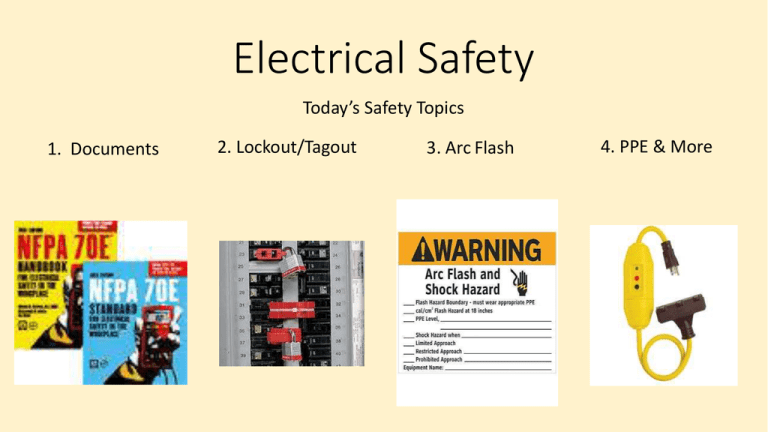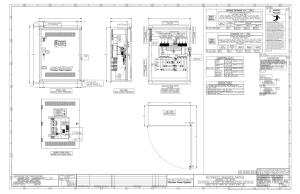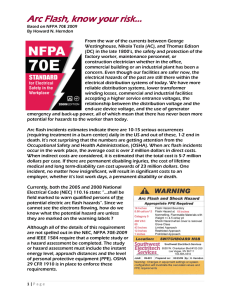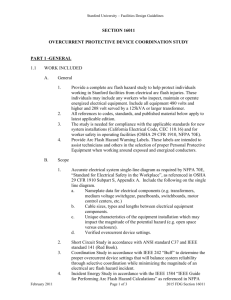Electrical Safety - PNWS-AWWA
advertisement

Electrical Safety Today’s Safety Topics 1. Documents 2. Lockout/Tagout 3. Arc Flash 4. PPE & More Don’t let Electrical Safety Accidents suddenly “Bite You” What major documents influence and guide electrical safety? 1. 2. 3. OSHA (Occupational Safety and Health Standards) This is the federal law. Think of it as regulations. NFPA 70 (National Electrical Code) and NFPA 70E (Standard for Electrical Safety in the Workplace). Think of this as Rules and recommendations. State Levels Washington Labor and Industries (RCW/WAC) Oregon Electrical Specialty Code Idaho State Electrical Bureau 4. 5. 6. Municipality or Employer Department or Section level YOU and Me!!!!!!! 1. Documents 1. Documents Relationship showing Safety documents OSHA Level Department or Section Level • Nothing wrong using this approach. Hard to do without prior years of exposure to these resources. NFPA 70 & NFPA 70E Level Electrical Safety for you and me. Municipality or Employer Levels States of Washington, Oregon and Idaho Levels Another way of looking at Safety document Relationships 1. Documents OSHA NFPA 70 & NFPA 70E • This relationship has the advantage of taking a logical (linear) approach of incorporating added safety features. Please note: Idaho has different relationship with OSHA. State Levels: Washington, Oregon, Idaho Municipality or Employer Department or Section Level You and Me 2. Documents OSHA STATE PLANS • Workers at state and local government agencies are not covered by federal OSHA, but have OSHA Act protections if they work in those states that have an OSHAapproved State Plan. • Washington and Oregon have approved State Plans that cover both private and public sector workers. • Idaho follows OSHA plan. History leading to Lockout/TagOut • In 1970, the Occupational Safety and Health Act became Law. • Enforcing employers to protect employees and others working for them. • States and Cities began to provide law and language. • NFPA 70 and NEMA (National Electrical Manufactures Association) working together began to establish rules, requirements, and methods to allow equipment with lockout features. • NFPA 70E first edition came out in 1979. • Current NFPA 70E is the 2015 edition. 2. Lockout/Tagout Major Significant Change for 2015 • Hold Tags are often used on outdoor electrical power equipment that does not have provisions for applying a lockout device. • When a hold tag is being used, the tag out procedure must contain a method of accounting for all employees working under its protection. So, when using a hold tag, all workers must be accounted for before the hold tag is removed and the circuit is energized. 2. Lockout Tagout Example of electrical equipment that would utilize a Holding Tag out method • This is a CT (Current Transformer) cabinet fed directly from the power company and is ahead of the main circuit protection device. In other words, can’t shut the power off to inspect and work on. 2. Lockout Tagout A few examples of lockout kits Note: NFPA 70E Is a great document resource for Lockout Tagout information!!! Question: Does plug cord connected equipment need to be locked out????? 2. Lockout Tagout 3. Arc Flash Big Change in NFPE 70E Art 130. Prohibited Boundaries no longer used: Only has Limited Approach and Shock Approach The 2015 NFPA 70E More than twice as many workers are killed and injured each year from electrical shock than from electrical arc flash. Approximately 50% of those killed and injured are non-electrical workers. They are unqualified, which means they cannot recognize a hazard and cannot be expected to avoid a hazard. Qualified persons must protect unqualified workers from exposure to electrical hazards by using barriers, signs, or attendants. Arc Flash: What is it? • Working on certain energized equipment has the potential to create both shock hazard and electrical arching flashes and/or explosions that can cause severe burns, injuries and even death. • Safety rules are in place to protect qualified and unqualified employees working or near such equipment. • All other workers not directly involved in repairs but work in the same area need to know about Arc Flash. 3. Arc Flash Don’t let Electrical Safety Accidents “Bite You” I wonder what PPE should be worn in these situations? 3. Arc Flash 3. Arc Flash Arc Flash Labels Remember to comply with the AHJ (Authority Having Jurisdiction). Art. 110.16: The Washington Cities Electrical Code adds language to the first paragraph of NFPA 70 Art. 110.16. To read as follows, The flash protection marking shall be an identification plate or label meeting ANSI Standards Z535.4-1998 or be of a type approved by the Code Official or designated representative. The plate or label may be mounted using adhesive. Goes on to say, The arc flash hazard shall be updated when a major modification, renovation or changes in the electrical distribution system that could affect the results of the arc flash analysis takes place. 3. Arc Flash PPE’s Working on Alternating Current (AC) based on Categories 1,2,4 • Categories are rated by the amount of energy and heat given off by the arc flash, measured in Calories. Three Important Elements to Understand with Energized Parts and Arc Flash Procedures 1. Approach boundaries for unqualified workers to Energized Electrical Conductors or Circuit Parts for Shock Protection 2. Equipment Labeling 3. Arc Flash PPE’s 3. Arc Flash Electrical PPE’s and more for Electrical Work. • Work Boots: No longer ANZI Z41 rated. Now have EH (Electrical Hazard) on label. • Safety Glasses: Electrical Safety glasses need to have UV rating. • Electrical Gloves: Have electrical ratings corresponding to voltage levels. • Hearing Protection • Hard Hats • Clothing • Jewelry, watches, etc….. • Voltage Meters and Volt Sticks • Portable GFCI devices • Extension Cords • Power Tools 4. Electrical PPE’s Be careful using a volt-stick!! • The volt-stick only tells you if there is a presence of voltage. Not a good choice of trouble shooting electrical problems. Good to have for safety. • Make sure you test the voltstick on a known energized circuit before testing on the one you are working on. 4. Electrical PPE’s GFCI Protection Avoid using portable GFCI in Series with another GFCI GFCI protects against current flow. 6 mA. 4. Electrical PPE’s Any Questions? Where to find Information: Great Place to find any of the Electrical Code and Safety material: Builders Book, Inc. 8001 Canoga Avenue, Canoga Park, Ca. 91304 www.buildersbook.com







